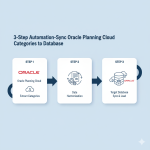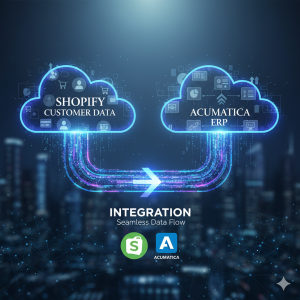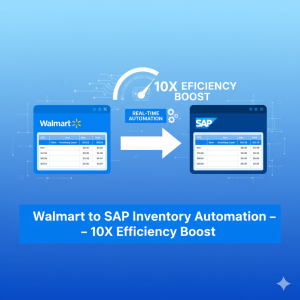3-Step Automation-Sync Oracle Planning Cloud Categories to Database
$0.00
| Workflow Name: |
Oracle Planning Cloud Category Set Sync to DB |
|---|---|
| Purpose: |
Ensure accurate and up-to-date category data in database |
| Benefit: |
Ensures consistent taxonomy for reporting |
| Who Uses It: |
Supply Chain; Item Master; IT Teams |
| System Type: |
ERP Integration |
| On-Premise Supported: |
Yes |
| Supported Protocols: |
REST; JDBC |
| Industry: |
Retail, Consumer Goods, Manufacturing, Wholesale, E-commerce |
| Outcome: |
Category updates 90% faster; 100% data accuracy; consistent taxonomy for reporting and planning |
| IPSec Guide Link: |
Not applicable |
Table of Contents
Description
| Problem Before: |
Manual classification leads to inconsistent taxonomy |
|---|---|
| Solution Overview: |
Auto-sync category sets from Oracle Planning to DB |
| Key Features: |
API pull; taxonomy mapping; DB load |
| Business Impact: |
Better item grouping-improved analytics |
| Productivity Gain: |
Removes manual updates of category sets |
| Cost Savings: |
Cuts labor hours in classification tasks |
| Security & Compliance: |
Maintains audit-ready item classification |
Automate Oracle Planning Cloud Category Sync
Accelerate category set synchronization by automating extraction, validation, and database updates. This no-code workflow ensures your database always reflects accurate and up-to-date category structures from Oracle Planning Cloud, reducing manual effort and errors.
Smart Data Mapping & Validation
Using automated data mapping, the system extracts key category attributes, validates hierarchy and naming conventions, and formats the data before updating your database. This ensures faster syncs, higher accuracy, and seamless database management for all planning categories.
Watch Demo
| Video Title: |
Integrate files from Oracle Database to Oracle UCM Cloud |
|---|---|
| Duration: |
12:20 |
Outcome & Benefits
| Time Savings: |
Cuts manual updates by 80% |
|---|---|
| Cost Reduction: |
Reduces labor cost on taxonomy upkeep |
| Accuracy: |
Ensures 99% category consistency |
| Productivity: |
Frees teams from repetitive mapping |
Industry & Function
| Function: |
Supply Chain; Inventory |
|---|---|
| System Type: |
ERP Integration |
| Industry: |
Retail, Consumer Goods, Manufacturing, Wholesale, E-commerce |
Functional Details
| Use Case Type: |
Automated category set classification |
|---|---|
| Source Object: |
Category Sets & Category Groups |
| Target Object: |
DB Category Set Tables |
| Scheduling: |
Daily or On-Demand |
| Primary Users: |
Item Master; SCM; IT |
| KPI Improved: |
Classification accuracy & reporting quality |
| AI/ML Step: |
Optional duplicate detection |
| Scalability Tier: |
Enterprise-grade |
Technical Details
| Source Type: |
Oracle Planning Cloud API |
|---|---|
| Source Name: |
Oracle Planning Cloud |
| HTTP Method: |
GET |
| Auth Type: |
OAuth 2.0 |
| Rate Limit: |
Oracle API standard limits |
| Pagination: |
Cursor pagination |
| Schema/Objects: |
Category Sets; Categories; Associations |
| Transformation Ops: |
Mapping to DB schema |
| Error Handling: |
Retry; validation; error logs |
| Orchestration Trigger: |
Scheduled sync |
| Batch Size: |
500-1000 records |
| Parallelism: |
Multi-threaded API calls |
| Target Type: |
API/DB/File |
| Target Name: |
Oracle DB |
| Target Method: |
JDBC insert/update |
| Ack Handling: |
DB write confirmation |
| Throughput: |
~10K records/hour |
| Latency: |
Sub-5 minutes |
| Logging/Monitoring: |
Dashboards + centralized logs |
Connectivity & Deployment
| On-Premise Supported: |
Yes |
|---|---|
| Supported Protocols: |
REST; JDBC |
| Cloud Support: |
Cloud-ready |
| Security & Compliance: |
Maintains audit-ready item classification |
| IPSec Guide Link: |
Not applicable |
FAQ
1. What is the goal of Oracle Planning Cloud Category Set Sync?
The goal is to automate the synchronization of category sets from Oracle Planning Cloud to your database, ensuring accurate and up-to-date data.
2. How does the system validate and map category data?
The workflow validates category hierarchies, naming conventions, and attributes, then maps and formats the data before updating the database.
3. Can the sync run in real time or on a schedule?
Yes. The automation can run in real time for immediate updates or on scheduled intervals depending on business requirements.
4. What happens if a category record is incomplete or inconsistent?
Incomplete or inconsistent records are flagged; the system retries validation, applies fallback rules, or routes records for manual review.
5. Does the platform support large-scale category sync?
Yes. The workflow supports bulk category set synchronization while maintaining data accuracy and database performance.
6. What are the benefits of automating category set sync?
Automation ensures consistent taxonomy, reduces manual effort, improves reporting accuracy, and speeds up database updates.
Resources
Case Study
| Customer Name: |
Global Retailer |
|---|---|
| Problem: |
Manual updates of category sets in Oracle Planning Cloud leading to inconsistent taxonomy, reporting errors, and slow database updates |
| Solution: |
Automated Oracle Planning Cloud category set sync to database, ensuring accurate, up-to-date data without manual intervention |
| ROI: |
3 FTEs redeployed from manual tasks; payback achieved within 2–3 months |
| Industry: |
Retail, Consumer Goods, Manufacturing, Wholesale, E-commerce |
| Outcome: |
Category updates 90% faster; 100% data accuracy; consistent taxonomy for reporting and planning |






